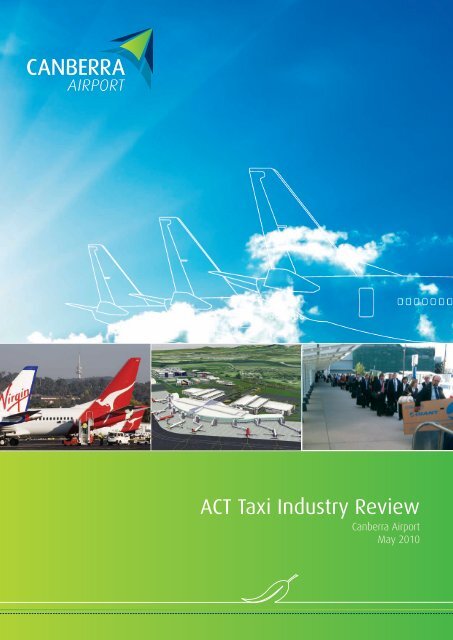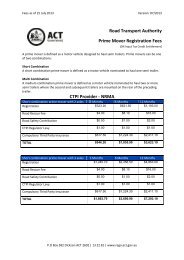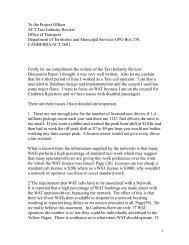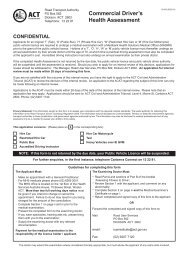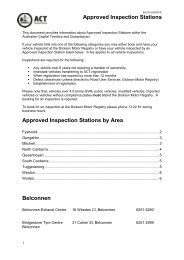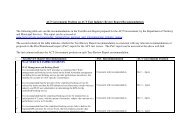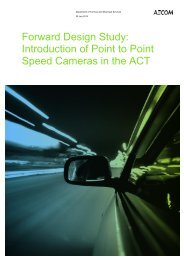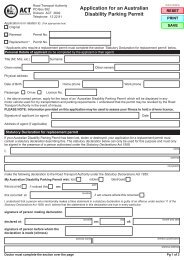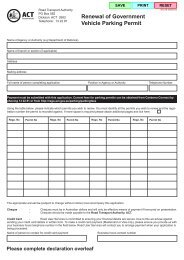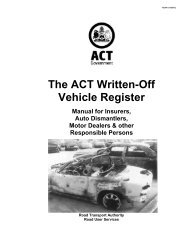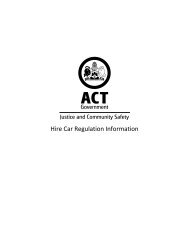Canberra Airport - Rego ACT - ACT Government
Canberra Airport - Rego ACT - ACT Government
Canberra Airport - Rego ACT - ACT Government
You also want an ePaper? Increase the reach of your titles
YUMPU automatically turns print PDFs into web optimized ePapers that Google loves.
<strong>ACT</strong> Taxi Industry Review<br />
<strong>Canberra</strong> <strong>Airport</strong><br />
May 2010<br />
| 1
1. Impact of Inadequate Taxi Services<br />
Put simply the taxi services currently provided in the <strong>ACT</strong> are:<br />
• costing the <strong>ACT</strong> and its community business and new jobs;<br />
• adversely affecting the image of <strong>Canberra</strong> as the nation’s capital city; and<br />
• not provided to an acceptable level.<br />
There are not enough taxis on the road at peak times, there are too many bookings being made<br />
which are not met, and the service is too unreliable to be used by business travellers.<br />
As a result, instead of our city appearing efficient and cost effective, it appears difficult to get<br />
around, inefficient and totally unreliable.<br />
The cumulative affect of the inadequate taxi service is a cost in business for the <strong>ACT</strong>.<br />
Conference organisers are refusing to consider <strong>Canberra</strong> for large and small conferences and<br />
conventions simply because of the reputation of the taxi service in the <strong>ACT</strong> – while this has a<br />
huge impact on the local economy, it is also an unacceptable situation for the National Capital<br />
of Australia.<br />
Examples of Poor Taxi Service<br />
There are numerous and continuous examples of the unavailability of taxis to the <strong>ACT</strong><br />
community. This occurs not only at peak times of the day and not only during peak weeks of<br />
the year, for example parliamentary sitting weeks. It happens at many different times of the<br />
day and in non parliamentary sitting weeks - it is just that it is even worse at peak times and<br />
during parliamentary sitting weeks.<br />
Some of the examples that demonstrate how the lack of taxi service manifests itself are as<br />
follows:<br />
(a)<br />
People seeking to catch a plane out of <strong>Canberra</strong> early in the morning are simply unable<br />
to book a taxi with any reliability. The taxi service states that when you make a<br />
telephone booking for a taxi the next morning, it is not a booking rather it is merely an<br />
expression of interest which they would hope to try and fulfil. Further any such<br />
expression of interest for an early morning taxi needs to be booked at least one hour<br />
earlier than when the taxi is required. Both of these situations are wholly unacceptable<br />
in a modern city in the 21 st century.<br />
It is the <strong>Airport</strong>’s submission that until the taxi industry gets to a situation where people<br />
can make bookings, for example early in the morning, with the reliability that they will<br />
be picked up and that they are treated as bookings rather than mere expressions of<br />
interest, then there clearly needs to be more taxi plates issued.<br />
In addition it should not be necessary to make a booking for a taxi more than 15 minutes<br />
before it is required to pick one up – especially at 5 o’clock in the morning. Again until
this situation is rectified, there is clear evidence under this metric that more cabs are<br />
required on the road.<br />
(b) There will often be no taxis at <strong>Canberra</strong> <strong>Airport</strong> in the morning. Each weekday the<br />
arrival of planes commences at approximately 8:15 - 8:20 and yet by 8:30 - 8:35, the<br />
available taxis have been reduced to zero and the taxi rank is bare. This occurs almost<br />
every weekday, including non parliamentary sitting weeks. The remaining passengers<br />
that need taxi services generally number 60 - 80 but in peak weeks will be as high as<br />
200 - 250 people. These people are only serviced by the ad-hoc arrival of 1-3 taxis that<br />
might arrive every 1 - 3 minutes. This is not the way that <strong>Canberra</strong>, as the National<br />
Capital, should be presenting itself at its entry and welcoming point to the city.<br />
The same situation plays itself out during the rest of the day at various other times when<br />
aircraft arrive, including 10:15 - 10:30, 3:00 - 3:30, and 4:30 - 6:00 to differing degrees.<br />
This situation is not caused by poor traffic to the airport (this is now resolved), it is not<br />
caused by the taxi industry withdrawing commissionaires at the <strong>Airport</strong>, it is not caused<br />
by a lack of drivers; it is simply caused by a lack of taxis in the market place.<br />
It might be said that these problems could be resolved by airport passengers using other<br />
modes of transport including buses or high occupancy taxis. This is simply not correct. The<br />
airport provides a bus and has on different occasions for weeks at a time provided free tickets<br />
to the Airliner bus direct to the city. Given that the bus stop was only 10 metres in front of<br />
the taxi rank, one would expect a modal shift to the bus. This does not occur because<br />
business travellers want a taxi. The reality is that business travellers want to be taken directly<br />
to the address for their meeting, not merely to some bus interchange in the middle of the city<br />
from which they have to face the challenge of navigating to an unknown destination at an<br />
unknown time distance away when they may already be running late for an important<br />
meeting.<br />
Further, whilst the airport has strongly supported the establishment of a HOTS service and<br />
facilitated that through cost free commercial arrangements offered to the taxi industry, the<br />
reality is that this will only improve the situation marginally because business travellers do<br />
not generally wish to multiple hire or share taxis. Business travellers often need to make<br />
telephone calls that are confidential and private in nature. The simple reality is that airport<br />
passengers lined up in the taxi queue want a taxi to take them directly to their destination and<br />
they want the privacy to be able to conduct their business while they are in transit. The<br />
business is there but the taxis are not.<br />
In the <strong>Airport</strong>’s view many of the issues surrounding the taxi industry arose of the then <strong>ACT</strong><br />
<strong>Government</strong> decision to freeze the issue of taxi plates in 1995 with a result that no taxi plates<br />
were issued for the following 11 years. This action has ultimately resulted in the taxi industry<br />
being unable to meet the demands of users.<br />
However, there are two observations that need to be made in relation to the issuing of the 90<br />
new leased licence plates between 2006 -2008:<br />
1. Despite claims from the taxi industry that the value of taxi plates themselves would<br />
collapse, that the licences would not be taken up and that the industry as a whole would<br />
fall apart, none of these eventualities occurred. In fact, the number of privately held taxi
licences sold increased in 2006 and 2007 and the average price of those licences<br />
increased between 2005 and 2007 by 15% from $264,000 to $296,000.<br />
2. Secondly, the number of drivers in the industry increased by more than 20% between<br />
2006 and 2009 – from 1068 drivers to 1263 drivers. This highlights that additional jobs<br />
are created in the <strong>ACT</strong> through the release of taxi licence plates.<br />
The greatest problem with this current taxi review is that it is being undertaken in<br />
circumstances where there has been a freezing in the balloting and issuance of licences since<br />
2008. Notwithstanding the fact that 50 new licences were issued through ballots in May and<br />
October 2008 – all of which were taken up – we are now facing a situation where it is likely<br />
to be at least 2 years between ballots for taxi licences. Given the unmet demand in the system<br />
and the services concerns this is a wholly unacceptable situation.
2. Should There Be A Cap On The Number Of Taxi Licences<br />
<strong>Canberra</strong> <strong>Airport</strong> agrees with the basic proposition of the OECD Report that the removal of<br />
the cap on the issuing of licences improves consumer welfare and that the restriction on<br />
competition is unjustified and results in less than an optimal result for consumers. This can<br />
be seen now in <strong>Canberra</strong>, where consumer satisfaction with taxi services has substantially<br />
declined with little incentive on the taxi industry to address those concerns due to the closed<br />
nature of the market. Indeed the simple reality is that the taxi industry is in complete denial<br />
about the extent of the problems and through self interest opposes the very measure that will<br />
fix the problem – more taxis on the road.<br />
Recommendation 66 of the Commonwealth <strong>Government</strong>’s Henry Tax Review states that the<br />
quantity limits on taxi licences should be phased out. The report notes that the restrictions on<br />
licences “are beyond those necessary to maintain service standards or safety and are simply<br />
used to raise revenue.” The Review notes that in terms of dealing with the transitional<br />
problem for existing owners, other than conducting a buy back, the price for licences (i.e the<br />
capital sum or the annual licence fee) could be reduced incrementally over time.<br />
The reality is that the taxi industry does operate in many cities in the world without a cap on<br />
licences and does so without compromising safety or quality of service standards – indeed the<br />
quality of service is substantially improved. In particular <strong>Canberra</strong> should look to the national<br />
capital of New Zealand, Wellington, as being a similar size city with a similar culture and<br />
value system in nature which successfully operates with a completely deregulated and<br />
uncapped taxi market.
3. How Many Taxi Licences Do We Need<br />
If the <strong>Government</strong> wishes to answer this question, the first thing it must acknowledge and put<br />
at the top of its requirements and key factors list is that <strong>Canberra</strong> is a city that exists to fulfil<br />
its role as the National Capital. As a consequence, it has a significant role in servicing the<br />
Australian <strong>Government</strong> and it must operate in such a way that facilitates the conduct of<br />
<strong>Government</strong> business and meet the needs of those engaging in business with the <strong>Government</strong>.<br />
In short, as a result of being the National Capital, <strong>Canberra</strong> has a significantly higher<br />
requirement for numbers of taxis operating on the road than other cities, due to the high level<br />
of government business and business travel.<br />
The extent of this is underlined by comparing the population of various capital cities in<br />
Australia to the number of airline passengers that travel to that city, noting of course that in<br />
<strong>Canberra</strong> there is a higher proportion of business travellers (who have a greater requirement<br />
for taxis) than for leisure passengers.<br />
Table 3.1 - <strong>Airport</strong> Passengers Numbers Vs Population<br />
Population<br />
<strong>Airport</strong><br />
Passengers<br />
<strong>Airport</strong> PAX Per<br />
Head Of Population<br />
Wellington NZ+ 478,600 5,374,000 11.23<br />
Brisbane 1,950,000 18,711,039 9.60<br />
<strong>Canberra</strong> 345,600 3,149,166 9.11<br />
Hobart 213,000 1,874,437 8.80<br />
Sydney 4,400,000 32,993,572 7.50<br />
Melbourne 3,900,000 24,882,230 6.38<br />
Perth 1,600,000 9,612,102 6.01<br />
Adelaide 1,170,000 6,841,747 5.85<br />
~ Data as provided in <strong>ACT</strong> <strong>Government</strong> discussion paper (Aug 2009)<br />
+ Taxi plates estimate only. Population data for Wellington region from Statistics NZ<br />
* Pax numbers from BITRE data available online (calendar year 2009)<br />
The above table indicates that <strong>Canberra</strong> has one of the highest ratios of airline passengers to<br />
city population. This in itself means that in <strong>Canberra</strong> there is a much higher requirement for<br />
taxis than other cities as many of those airline passengers will require taxi services. As such,<br />
when examining the ratio of taxi plates to population in cities, one has to keep in mind that<br />
<strong>Canberra</strong> needs more taxi plates for its population (on a proportionate basis) than cities such<br />
as Perth and Adelaide and substantially more than Melbourne and Sydney (which also have a<br />
highly functional and available public transport system) simply because proportionately it has<br />
a greater number of airline passengers.<br />
Accordingly, an appropriate metric (amongst others) to examine the question of taxis<br />
appropriate for a market is the number of airport passengers per taxi plate:
Table 3.2 - Taxis Vs <strong>Airport</strong> Passenger Numbers<br />
Taxis<br />
<strong>Airport</strong><br />
Passengers<br />
<strong>Airport</strong> PAX Per<br />
Taxi<br />
Brisbane 1,867 18,711,039 10,022<br />
<strong>Canberra</strong> 333 3,149,166 9,457<br />
Hobart 261 1,874,437 7,182<br />
Adelaide 1,039 6,841,747 6,585<br />
Sydney 5,210 32,993,572 6,333<br />
CBR Option 1 500 3,149,166 6,298<br />
Melbourne 4,020 24,882,230 6,190<br />
CBR Option 2 600 3,149,166 5,249<br />
Perth 1,849 9,612,102 5,199<br />
Wellington NZ+ 1,970 5,374,000 2,728<br />
~ Taxi data as provided in <strong>ACT</strong> <strong>Government</strong> discussion paper (Aug 2009)<br />
+ Based on year end Mar 09 passenger numbers. Taxi plates estimate only<br />
* Pax numbers from BITRE data available online (calendar year 2009)<br />
As the above table shows if <strong>Canberra</strong> had in the order of 500 taxi plates, we would have a<br />
ratio of taxis to passengers approximately equal to Sydney and Melbourne, yet they have<br />
significant public transport infrastructure.<br />
At 600 taxi plates, we would still have a poorer ratio than Perth, notwithstanding our<br />
significantly greater business travel and weaker public transport system.<br />
This analysis shows that at a minimum – to just to meet the standards of other cities -<br />
<strong>Canberra</strong> requires 500 to 600 taxis (noting that we would then still then have a service<br />
substantially less than that provided at Wellington). The question is of how to get there and<br />
this includes issues of transition, reducing the cost of <strong>Government</strong> charges and improving the<br />
training and structure of the industry.<br />
It is our recommendation, as indicated below, that whilst a cap is removed on the total number<br />
of overall taxi licences, that the number of licences to be issued be restricted to a certain<br />
number of licences per annum for the next 5 to 10 years as a method of incrementally moving<br />
to market equilibrium and allowing the industry to adjust.
4. How Many Taxi Licences Should Be Issued<br />
While <strong>Canberra</strong> <strong>Airport</strong> believes that there is an immediate unmet demand for at least 130 -<br />
150 taxis, it is recommended that there be an initial ballot of 75 - 100 additional taxi plates.<br />
It is then recommended that the <strong>Government</strong> ballot off an additional 40 - 50 taxi plates per<br />
annum for the next 5 to 7 years. Subject to our comments below on varying the number<br />
plates in each ballot, these ought to be done in half yearly issuances of between 15 and 25<br />
plates and we would suggest that the first half yearly ballot after the initial 75 -100 plates be<br />
for 15 plates.<br />
We would also propose a simple mechanism for varying the number of plates available at<br />
each six monthly ballot as follows:<br />
(a)<br />
if 5 or more plates fail to sell at a ballot - then at the next ballot, the number of taxi<br />
plates available would reduce by the number of unpurchased taxi plates in the previous<br />
ballot;<br />
(b) if all plates are purchased at ballot - then the number of plates made available at the<br />
next ballot would be increased by 5; and<br />
(c)<br />
if less than 5 plates fail to sell at a ballot, but not all the plates are purchased – then there<br />
would be no change to the number of plates available for purchase in the next ballot.<br />
This is a simple and effective mechanism to ensure that the market is supplied with additional<br />
taxi plates to meet growing market demand as well as adjusting for the historical shortfall in<br />
supply in a measured way which ensures that the market will not be flooded.<br />
It should not be forgotten that the issuance of additional taxi plates will create additional jobs<br />
in the <strong>Canberra</strong> economy – directly through the employment of additional drivers and<br />
secondly through the flow on business that will be created by recapturing some of the lost<br />
convention business that <strong>Canberra</strong> is currently missing out on.<br />
It is forecast that the initial ballot of 100 additional licences would create between 120 and<br />
150 new jobs in the <strong>ACT</strong>.<br />
In addition, the issuance of additional taxi plates is an important road safety issue for the <strong>ACT</strong><br />
– the availability of more taxis will assist in reducing the incidence of drink driving, and<br />
violence in late night taxi queues in Civic. In this regard, it needs to be acknowledged that the<br />
bus service in the <strong>ACT</strong> does not have sufficient frequency or availability of service in late<br />
night hours, resulting in a corresponding increase demand for the provision of taxi services.<br />
This mechanism of regular supply of taxi plates ensures that if estimates of unmet taxi plate<br />
demand are wrong or if circumstances change, then the <strong>Government</strong> will receive signals from<br />
the ballot on a six monthly basis as to how many taxi plates are required. The simple fact is<br />
that if there are too many plates to be financially sustainable then investors and drivers will<br />
not take up the additional 15 - 20 plates that might be available at any particular auction. It<br />
must, however, be recognised that such an outcome may not imply an over supply in the<br />
market but rather that the market has reached an equilibrium. Subsequent ballots would result
in the issuance of additional licences equal to the market’s assessment of the unmet demand<br />
for taxi plates and taxi services.<br />
No matter what form of benchmarking the <strong>Government</strong> might implement in relation to trying<br />
to determine the number of taxi plates to issue, it will always run the risk of being wrong in<br />
the eyes of the taxi industry or consumers. However, a mechanism such as that described<br />
above will allow for the regular availability of plates, but also provide true signals and advice<br />
to <strong>Government</strong> and the market as to the current financial sustainability of the market.
5. Peak Period Plates<br />
<strong>Canberra</strong> <strong>Airport</strong> submits that Peak Period Plates are a device used to remedy existing failings<br />
in the market – it is a situation where the regulator attempts to “fix” supply and demand at a<br />
particular time because the regulator has been unable to “fix” supply and demand for the<br />
market in general. The operation of Peak Period Plates is complex, is difficult to enforce and<br />
is really just a symptom of a market with structural failings.<br />
Accordingly, in pure market terms, the only situation in which Peak Period Plates should be<br />
required would be where either:<br />
1. An inadequate number of plates is being supplied for the general market; or<br />
2. The annual licencing fee for normal plates is set at too high a level to allow normal taxi<br />
plates to be financially viable to cover both the demands at peak period times and the<br />
lulls in non-peak times.<br />
Accordingly, in our opinion, the better solution is not to have Peak Period Plates but rather to<br />
ensure that there is an uncapped system of issuance of taxi plates and secondly that the annual<br />
licence fee is not set at a prohibitive level.<br />
Having said that, given the critical shortage of taxis at peak periods throughout <strong>Canberra</strong>,<br />
<strong>Canberra</strong> <strong>Airport</strong> would welcome any solution that resulted in an immediate increase in the<br />
number of available taxis – if the only way to do this is through the issuing of Peak Period<br />
Plates, then that solution needs to be adopted as a matter of urgency.
6. Licence Fee<br />
In order to improve the quality of service of the taxi industry while at the same time releasing<br />
more plates, it will be necessary to substantially lower the annual licence fee charged by the<br />
<strong>ACT</strong> <strong>Government</strong>. The annual licence fee of $20,000 is currently causing higher fares, lower<br />
returns to investors, and lower incomes earned by drivers, consequently resulting in<br />
reductions in service quality while limiting the ability of the <strong>Government</strong> to issue more plates.<br />
In our opinion the licence fee should be reduced from $20,000 to $1,500 per annum, but in<br />
any event it should not exceed $5,000 per annum in any circumstance. To ensure equity<br />
across the industry this reduction should apply to both existing and new taxi licences, and to<br />
ensure that the full benefit of this reduction is passed on to drivers and investors, <strong>Canberra</strong><br />
<strong>Airport</strong> submits that the current fare levels should not be reduced.<br />
The reality is that the loss to the community and to the city through poor quality of service<br />
and lost business is much greater than the revenue lost by the <strong>Government</strong> through this<br />
proposed reduction in licence fees. It is a taxing impost on an undersupplied industry that is<br />
reducing the number of taxis that can viably and sustainably afford to operate in the market.<br />
A reduction in the fee in this way is consistent with the Henry Review Tax Reforms.<br />
In relation to Peak Period Plates, it is recommended that the licence fee is set at no more than<br />
$500 per annum.<br />
As an alternative to reducing the licence fee with immediate affect, this reduction could be<br />
phased in gradually over the next five to seven years, with an immediate reduction to $15,000<br />
per annum, then a reduction to $10,000 per annum in two years time, followed by a reduction<br />
to $1,500 per annum two years after that.
7. Service Performance<br />
In relation to the actual performance of taxis, as noted previously, all indicia of customer<br />
satisfaction appears to be on the decline rather than on the improve. In this context, <strong>Canberra</strong><br />
<strong>Airport</strong> believes that performance measures are an integral part of ensuring good customer<br />
service. At a minimum these performance measures should cover the following:<br />
• Availability - time - One of the most important elements is that taxi co-operatives are<br />
able to provide taxis on a 24 hour basis. It is not acceptable that one of the companies<br />
involved in providing taxi services to <strong>Canberra</strong> <strong>Airport</strong> is only able to provide vehicles<br />
up to 10:30pm.<br />
• Availability – in service - Performance measures must be implemented to ensure that a<br />
specific percentage of the fleet is available at all times – this is particularly important in<br />
relation to peak periods. At the moment owners decide if their taxi is going to be<br />
available or not and often that decision is based on their own personal circumstance<br />
rather than the need of the market, the customer or the wider industry.<br />
• Assessment of Service - <strong>Canberra</strong> <strong>Airport</strong> believes that an independent assessment of<br />
customer satisfaction should be undertaken on a regular basis and should include issues<br />
such as:<br />
o<br />
o<br />
o<br />
o<br />
o<br />
o<br />
o<br />
compliance with booking arrangements;<br />
the drivers knowledge of the <strong>Canberra</strong> region;<br />
the standard of presentation of both drivers and the vehicles;<br />
the visibility of driver identification;<br />
the implementation of a complaints system and resolution of those complaints;<br />
the availability of EFTPOS facilities; and<br />
the performance of the driver.<br />
The above are just examples of performance measure that could be considered – the point is<br />
that we need to have an open discussion about these measures and how they can best be<br />
implemented across the taxi industry.
8. Fare – Commercial Viability And Deregulation<br />
<strong>Canberra</strong> <strong>Airport</strong> accepts that a number of our proposals will have a commercial impact on<br />
the taxi industry. Notwithstanding this, <strong>Canberra</strong> <strong>Airport</strong> does not support the complete<br />
deregulation of the determination of the fare – <strong>Canberra</strong> <strong>Airport</strong> is concerned that if the<br />
determination of the fare is completely deregulated there is a potential for a marked decrease<br />
in the service offering and quality provided to the end consumer. (With reductions in fares as<br />
a result of greater competition through an open market, there are inevitably cost cuts and<br />
service reductions).<br />
<strong>Canberra</strong> <strong>Airport</strong> is a supporter for the pricing and structure of fares to allow for the recovery<br />
of all costs associated with the taxi industry including the provision of commissionaires, staff<br />
training, uniforms, performance measure implementation, costs of licences etc. In this regard,<br />
<strong>Canberra</strong> <strong>Airport</strong> accepts that the taxi industry is a commercial business and should be<br />
allowed to function that way. There needs to be an acknowledgement that with higher service<br />
standards, more plates and with our smaller population base, fares cannot be set at a similar<br />
level as the larger locations - it is in some ways only natural that our fares should be higher.<br />
If we are to increase the number of plates (something that <strong>Canberra</strong> <strong>Airport</strong> believes is<br />
essential), at the same time implement a series of performance measures, as well require the<br />
provision of commissionaires at certain taxi ranks (something that <strong>Canberra</strong> <strong>Airport</strong> believes<br />
is essential to the efficient operation of the taxi industry), and given our smaller population as<br />
compared to the larger cities - then there will be additional costs which will need to be<br />
included in the taxi fare.
9. <strong>Canberra</strong> <strong>Airport</strong><br />
As we have raised on many occasions, there is no doubt that the supply of taxis for passengers<br />
utilising <strong>Canberra</strong> <strong>Airport</strong> is a matter of significant concern and one that reflects poorly upon<br />
<strong>Canberra</strong> as the Nation’s capital. In this regard, and for your information, we attach<br />
correspondence and photos which indicate the unavailability of taxis for members of the<br />
public who use <strong>Canberra</strong> <strong>Airport</strong>. You will note that for the most part these lines, which have<br />
developed due to the unavailability of taxis not because of any failure of infrastructure at<br />
<strong>Canberra</strong> <strong>Airport</strong>, have occurred during normal hours when one would have expected that<br />
taxis would be available to provide the necessary services.<br />
In <strong>Canberra</strong> <strong>Airport</strong>’s opinion, many of the issues surrounding the provision of services at<br />
<strong>Canberra</strong> <strong>Airport</strong> can be resolved by implementing a number of the matters that we have<br />
discussed above. In particular <strong>Canberra</strong> <strong>Airport</strong> believes that taxi services at the <strong>Airport</strong><br />
would be greatly improved through the following:<br />
• The immediate release of more taxi licences – ideally <strong>Canberra</strong> <strong>Airport</strong> believes that<br />
these should be full taxi licences, but if not, at a minimum there need to be peak period<br />
taxi plates issued immediately as discussed above.<br />
• The provision of HOT services – <strong>Canberra</strong> <strong>Airport</strong> has offered on a number of<br />
occasions a dedicated rank for these services. <strong>Canberra</strong> <strong>Airport</strong> believes that these<br />
services would be particularly effective given that many passengers are travelling to the<br />
<strong>Canberra</strong> CBD.<br />
• The implementation of a rigorous set of performance measures – <strong>Canberra</strong> <strong>Airport</strong><br />
believes that these performance measures would improve the general service experience<br />
for customers of the <strong>Airport</strong>, as discussed above.<br />
• The provision of a commissionaire – as with other airports we believe that a<br />
commissionaire at the airport organising the efficient provision of taxi services to the<br />
public is essential during peak hours. As noted in our submission above we believe the<br />
cost of such a commissionaire should be built into the fare imposed by taxi operators.<br />
The <strong>Airport</strong> does not support additional surcharges being imposed on taxi customers who are<br />
picked up from the <strong>Airport</strong>. Such a tolling or increased fare mechanism is not only totally<br />
inequitable but would represent an additional tax being imposed on taxi customers due to the<br />
market failure of the restriction in supply of taxis. Quite simply, before one even<br />
contemplates such a policy, one must first issue more taxi plates and remove the cap on their<br />
availability.
2 | <strong>Canberra</strong> <strong>Airport</strong> 2009 Environment Management System<br />
2 Brindabella Circuit, Brindabella Business Park <strong>ACT</strong> 2609<br />
T 02 6275 2222 F 02 6275 2244 W www.canberraairport.com.au


